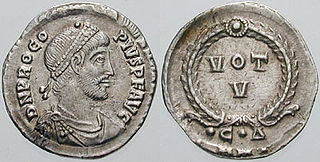
The 80s was a decade that ran from January 1, AD 80, to December 31, AD 89.

100 (C) was a leap year starting on Wednesday of the Julian calendar, the 100th year of the Common Era (CE) and Anno Domini (AD) designations, the 100th year of the 1st millennium, the 100th and last year of the 1st century, and the 1st year of the 100s decade. As of the start of 100, the Gregorian calendar was 2 days behind the Julian calendar, which was the dominant calendar of the time.

The 130s was a decade that ran from January 1, 130, to December 31, 139.
The 140s decade ran from January 1, 140, to December 31, 149.
The 150s decade ran from January 1, 150, to December 31, 159.
The 160s decade ran from January 1, 160, to December 31, 169.
The 170s decade ran from January 1, 170, to December 31, 179.
Year 130 (CXXX) was a common year starting on Saturday of the Julian calendar. At the time, it was known as the Year of the Consulship of Catullinus and Aper. The denomination 130 for this year has been used since the early medieval period, when the Anno Domini calendar era became the prevalent method in Europe for naming years.
Year 140 (CXL) was a leap year starting on Thursday of the Julian calendar. At the time, it was known as the Year of the Consulship of Hadrianus and Caesar. The denomination 140 for this year has been used since the early medieval period, when the Anno Domini calendar era became the prevalent method in Europe for naming years.
Year 165 (CLXV) was a common year starting on Monday of the Julian calendar. At the time, it was known as the Year of the Consulship of Orfitus and Pudens. The denomination 165 for this year has been used since the early medieval period, when the Anno Domini calendar era became the prevalent method in Europe for naming years.
Year 175 (CLXXV) was a common year starting on Saturday of the Julian calendar. At the time, it was known as the Year of the Consulship of Piso and Iulianus. The denomination 175 for this year has been used since the early medieval period, when the Anno Domini calendar era became the prevalent method in Europe for naming years.
Year 551 (DLI) was a common year starting on Sunday of the Julian calendar. The denomination 551 for this year has been used since the early medieval period, when the Anno Domini calendar era became the prevalent method in Europe for naming years.

Year 1033 (MXXXIII) was a common year starting on Monday of the Julian calendar.
Year 182 (CLXXXII) was a common year starting on Monday of the Julian calendar. At the time, it was known as the Year of the Consulship of Sura and Rufus. The denomination 182 for this year has been used since the early medieval period, when the Anno Domini calendar era became the prevalent method in Europe for naming years.

Year 365 (CCCLXV) was a common year starting on Saturday of the Julian calendar. At the time, it was known in the West as the Year of the Consulship of Augustus and Valens. The denomination 365 for this year has been used since the early medieval period, when the Anno Domini calendar era became the prevalent method in Europe for naming years.
Year 188 BC was a year of the pre-Julian Roman calendar. At the time it was known as the Year of the Consulship of Messalla and Salinator. The denomination 188 BC for this year has been used since the early medieval period, when the Anno Domini calendar era became the prevalent method in Europe for naming years.

Annia Galeria Faustina the Elder, sometimes referred to as Faustina I or Faustina Major, was a Roman empress and wife of the Roman emperor Antoninus Pius. The emperor Marcus Aurelius was her nephew and later became her adopted son, along with Emperor Lucius Verus. She died early in the principate of Antoninus Pius, but continued to be prominently commemorated as a diva, posthumously playing a prominent symbolic role during his reign.

Tlos was an ancient Lycian city near the modern town of Seydikemer in the Mugla Province of southern Turkey, some 4 kilometres northwest of Saklıkent Gorge.
The 365 Crete earthquake occurred at about sunrise on 21 July 365 in the Eastern Mediterranean, with an assumed epicentre near Crete. Geologists today estimate the undersea earthquake to have been a moment magnitude 8.5 or higher. It caused widespread destruction in the central and southern Diocese of Macedonia, Africa Proconsularis, Egypt, Cyprus, Sicily, and Hispania (Spain). On Crete, nearly all towns were destroyed.
The 141 Lycia earthquake occurred in the period AD 141 to 142. It affected most of the Roman provinces of Lycia and Caria and the islands of Rhodes, Kos, Simi and Serifos. It triggered a severe tsunami which caused major inundation. The epicenter for this earthquake is not well constrained, with locations suggested at the northern end of Rhodes, on the Turkish mainland north of Rhodes near Marmaris and beneath the sea to the east of Rhodes.






